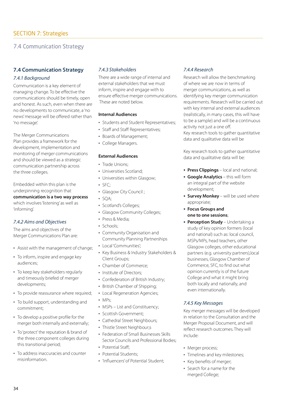
34
SECTION 7: Strategies
7.4 Communication Strategy
7.4 Communication Strategy
7.4.1 Background
Communication is a key element of
managing change. To be ef ective the
communications should be timely, open
and honest. As such, even when there are
no developments to communicate, a 'no
news' message will be of ered rather than
'no message'.
The Merger Communications
Plan provides a framework for the
development, implementation and
monitoring of merger communications
and should be viewed as a strategic
communication partnership across
the three colleges.
Embedded within this plan is the
underpinning recognition that
communication is a two way process
which involves 'listening' as well as
'informing'.
7.4.2 Aims and Objectives
The aims and objectives of the
Merger Communications Plan are:
Assist with the management of change;
To inform, inspire and engage key
audiences;
To keep key stakeholders regularly
and timeously briefed of merger
developments;
To provide reassurance where required;
To build support, understanding and
commitment;
To develop a positive proi le for the
merger both internally and externally;
To 'protect' the reputation & brand of
the three component colleges during
this transitional period;
To address inaccuracies and counter
misinformation.
•
•
•
•
•
•
•
•
7.4.3 Stakeholders
There are a wide range of internal and
external stakeholders that we must
inform, inspire and engage with to
ensure ef ective merger communications.
These are noted below.
Internal Audiences
Students and Student Representatives;
Staf and Staf Representatives;
Boards of Management;
College Managers.
External Audiences
Trade Unions;
Universities Scotland;
Universities within Glasgow;
SFC;
Glasgow City Council ;
SQA;
Scotland's Colleges;
Glasgow Community Colleges;
Press & Media;
Schools;
Community Organisation and
Community Planning Partnerships
Local 'Communities';
Key Business & Industry Stakeholders &
Client Groups;
Chamber of Commerce;
Institute of Directors;
Confederation of British Industry;
British Chamber of Shipping;
Local Regeneration Agencies;
MPs;
MSPs - List and Constituency;
Scottish Government;
Cathedral Street Neighbours;
Thistle Street Neighbour;s
Federation of Small Businesses Skills
Sector Councils and Professional Bodies;
Potential Staf ;
Potential Students;
'Inl uencers' of Potential Student;
•
•
•
•
•
•
•
•
•
•
•
•
•
•
•
•
•
•
•
•
•
•
•
•
•
•
•
•
•
•
•
7.4.4 Research
Research will allow the benchmarking
of where we are now in terms of
merger communications, as well as
identifying key merger communication
requirements. Research will be carried out
with key internal and external audiences
(realistically, in many cases, this will have
to be a sample) and will be a continuous
activity not just a one of .
Key research tools to gather quantitative
data and qualitative data will be
Key research tools to gather quantitative
data and qualitative data will be:
Press Clippings - local and national;
Google Analytics - this will form
an integral part of the website
development;
Survey Monkey - will be used where
appropriate;
Focus Groups and
one to one sessions;
Perception Study - Undertaking a
study of key opinion formers (local
and national) such as: local council,
MSPs/MPs, head teachers, other
Glasgow colleges, other educational
partners (e.g. university partners),local
businesses, Glasgow Chamber of
Commerce, SFC, to i nd out what
opinion currently is of the future
College and what it might bring
both locally and nationally, and
even internationally.
7.4.5 Key Messages
Key merger messages will be developed
in relation to the Consultation and the
Merger Proposal Document, and will
rel ect research outcomes. They will
include:
Merger process;
Timelines and key milestones;
Key benei ts of merger;
Search for a name for the
merged College;
•
•
•
•
•
•
•
•
•